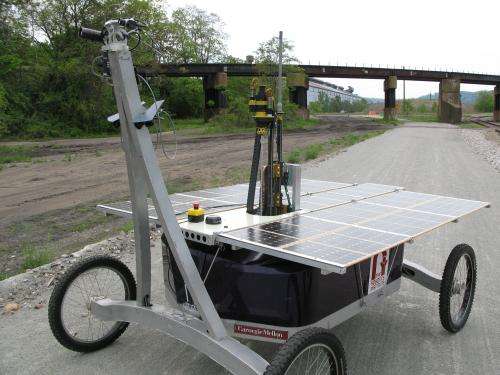Zoe robot returns to Chile's Atacama Desert On NASA mission to search for subsurface life

The autonomous, solar-powered Zoë, which became the first robot to map microbial life during a 2005 field expedition in Chile's Atacama Desert, is heading back to the world's driest desert this month on a NASA astrobiology mission led by Carnegie Mellon University and the SETI Institute. This time, Zoë is equipped with a one-meter drill to search for subsurface life.
As before, Zoë will be testing technologies and techniques that will be necessary for exploring life on Mars. NASA's Curiosity rover is finding life-friendly areas on the Red Planet and the space agency now is deciding how best to equip a rover set to follow in Curiosity's tracks in 2020.
"Direct evidence of life, if it exists, is more likely underground, beyond the current reach of rovers," said David Wettergreen, research professor in Carnegie Mellon's Robotics Institute and the principal investigator for the Life in the Atacama project. So Zoë has been fitted with a drill made by Honeybee Robotics than can bore deep into the ground.
"Chances improve with greater depth but we are first developing one-meter capability and integrating with a mobile robot," Wettergreen added.
The robot's auger will dredge up soil samples that can be analyzed with several on-board instruments. One of these is the Mars Microbeam Raman Spectrometer, an early candidate for the 2020 Mars mission, which can analyze mineral and elemental composition of soil.
"We are measuring the subsurface habitats in which life survives, determining what factors are important, and learning about one of the Earth's harshest climates," said Planetary Geologist Nathalie Cabrol, senior research scientist at the Carl Sagan Center of the SETI Institute, who is the science lead for the Life in the Atacama project.
In addition to Honeybee, the project includes collaborators at Universidad Catolica del Norte in Chile, the University of Tennessee, Washington University and the Jet Propulsion Laboratory. The project is supported by a $3 million grant from NASA.
Last year, in the first year of the three-year project, Cabrol, Wettergreen and other team members went to the Atacama without Zoë, visiting a variety of sites. They used a neutron detection instrument that measures hydrogen abundance to quantify moisture, several spectrometers to measure mineral and elemental composition of soils, and other instruments. They bored holes with hand-held drilling equipment and manually operated the instruments.
The findings from the first-year experiments will provide a comparison to what the robot can do automatically during field experiments this year and next.
The expedition confirmed that microorganisms are present in the Atacama soils, though extremely scarce. It also discovered a problem with the neutron detection instrument, called the Dynamic Albedo of Neutrons (DAN). The radioactive tritium in its neutron generator had decayed to the point that it could no longer function. Wettergreen said NASA had planned to use an identical DAN instrument aboard Curiosity later in its mission, but changed tempo once the Atacama discovery showed that the instrument would not survive as long as planned.
Zoë will undergo engineering tests in Chile this week in preparation for two weeks of scientific field experiments. The scientific trek will begin June 17 and will cover a 30-50 kilometer traverse in the hyper-arid core of the desert. One or two drilling operations are anticipated each day. The scientists plan to post updates during the trek on the project website, http://www.frc.ri.cmu.edu/projects/atacama/.
Though previous expeditions with Zoë have emphasized technology for autonomous operation of the robot, Wettergreen said the focus this time will be on gathering scientific data. "Now, we think of the robot as a tool to collect specific data from specific locations, rather than as a machine that drives around," he said.
One technical goal is to have multiple days of completely autonomous operation executing the scientists' plans regarding where they want the robot to go and how much data to collect at each point, then hibernating for the night and automatically resuming its plan when the sun returns.
Zoë is a four-wheeled robot, about 9 feet long and 6 feet wide. A solar array measuring three square meters lies flat atop its body, generating power with high-efficiency gallium arsenide solar cells. Because it is totally solar-powered, the robot operates primarily during the day, though it may do some processing of scientific samples overnight.
Provided by Carnegie Mellon University





















